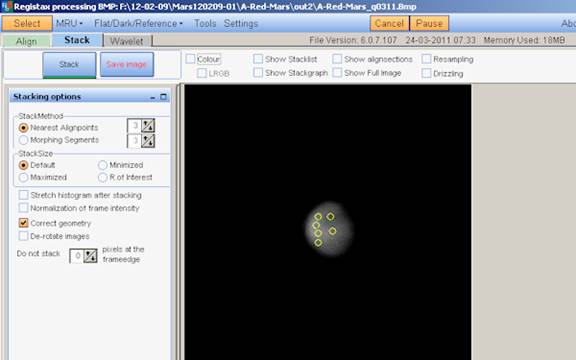


To edit the mineral moon, we first need to photograph it. I have used my own image to show the various steps, so you get to see and learn the entire process. In this article, we will cover the process of photographing and editing the mineral moon.
#Registax software iso#
Here is an image that was shot of a 93% waxing gibbous moon: 93% waxing gibbous moon shot at 600 mm, 1/640 sec at f/11, ISO 400. Going extreme on saturation will make the colours look awkward and the moon look fake. Now, the colours are not deep but subtle and we need to gently enhance those colours and make the moon look natural. If you want to learn more about the colours of the moon, go and have a read here on Universe Today and for more information on the minerals read the Lunar Resources on Wikipedia. The blue colour is caused by the higher amount of titanium on the lunar soil, the orange red colour due to iron and the other colours are caused by other minerals and where titanium is found in a lesser percentage. In addition to what we usually see, there are subtle blue, orange and other colours on the surface of the moon.
#Registax software full#
The moon looks almost flat on a full moon day because of the lack of shadows that usually enhance the surface details of the lunar surface.

When we photograph the moon, depending on atmospheric conditions or the position of moon in the sky, we get a “white or off-white” looking moon or an orange red tint if we photograph it during moonrise or moonset. What We See Versus The Colours On The Moon These compounds are found in the form of minerals, for example, the mineral ilmenite is found on the surface of the moon and it is a compound that contains iron, titanium and oxygen, olivine contains iron, magnesium, silicon and oxygen, etc. Some of the compounds on the lunar surface are iron oxide, titanium dioxide, magnesium oxide, aluminium oxide, silicon dioxide, sodium oxide, calcium oxide, etc. There are various metal and mineral deposits on the moon's surface in the form of compounds. Lunar nearside with major maria and craters labelled. The Highlands are the lighter areas and have a lot of craters.Maria ( singular is mare) in latin translates for seas and the reason behind this is the early astronomers mistaking these areas for actual seas and hence they are named that way. The Maria are the large darker areas that we are able to see on the moon's surface and these are formed as a result of ancient volcanic eruptions.The Lunar landscape is characterised by the Maria and the Highlands apart from other lava channels, domes, ridges, tectonic features, etc. We all like to know where the moon gets its colours from – so we thought it would be a good idea to give a brief and quick overview of what gives our moon its colours. Where Does The Moon Get Its Colours From? Image by Guillermo Ferla

These are due to various mineral deposits found in the lunar soil. You can see some brownish orange and blue colours on the moon's surface. The mineral moon is nothing but our moon with edited colours on its surface to reveal the mineral deposits. It’s surely not a big grey ball in the sky! Image by Neven Krcmarek What Is A Mineral Moon? It has blue, cyan, purple and brown colors that represent the elements of titanium and iron on the surface of the moon. This is how the moon looks like when you enhance the colors of the surface.


 0 kommentar(er)
0 kommentar(er)
